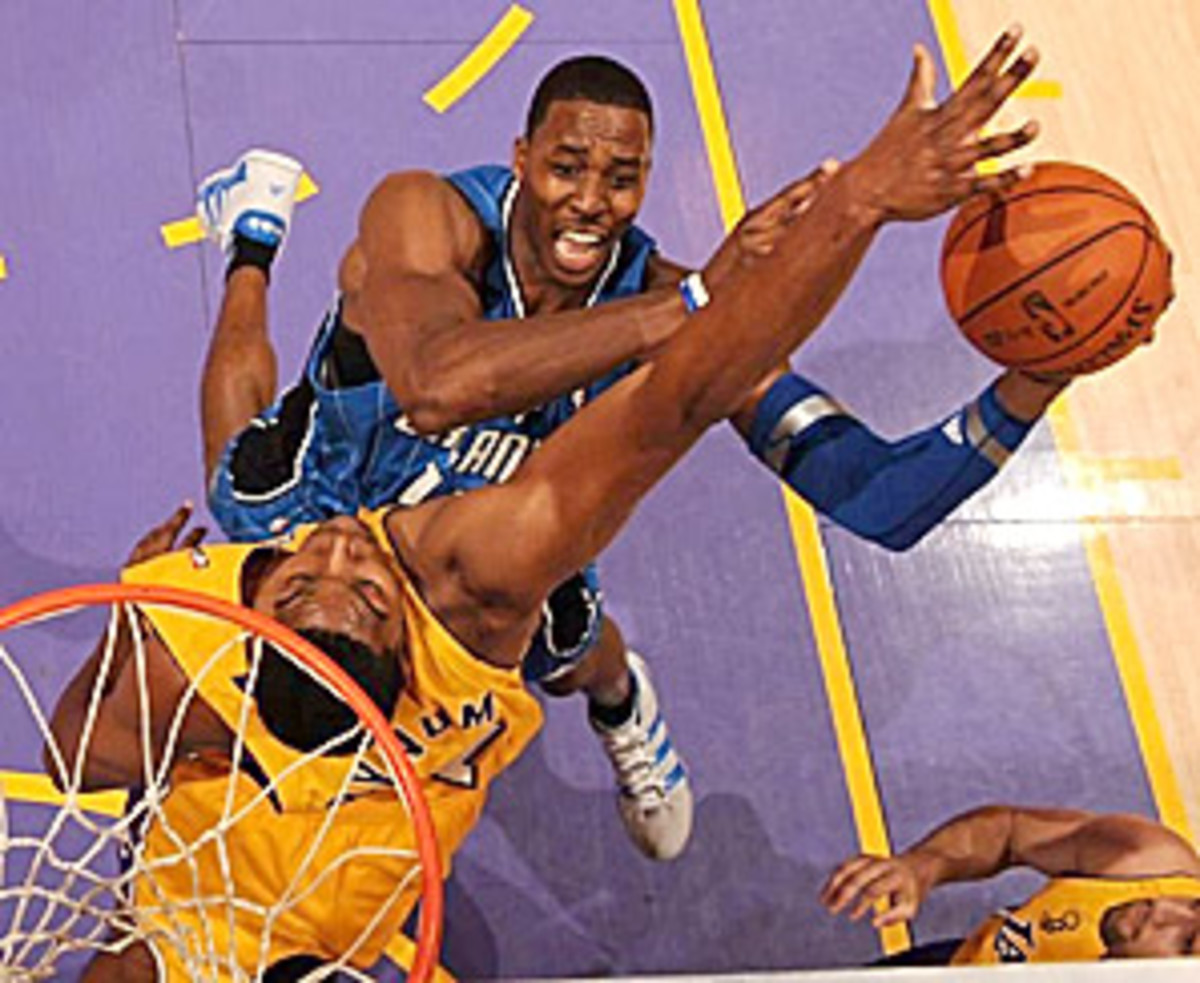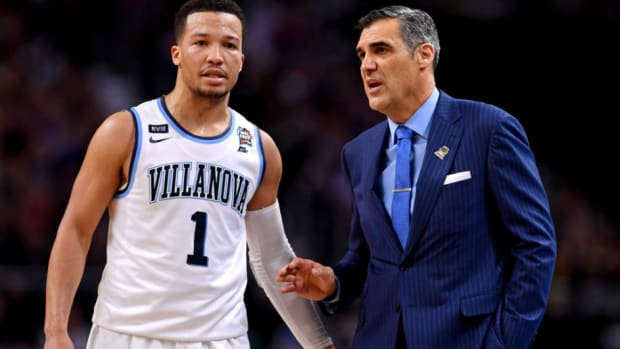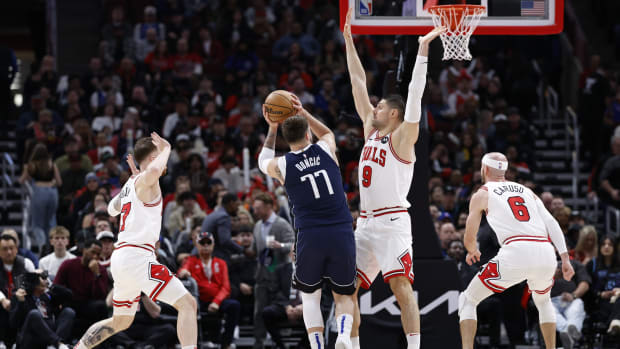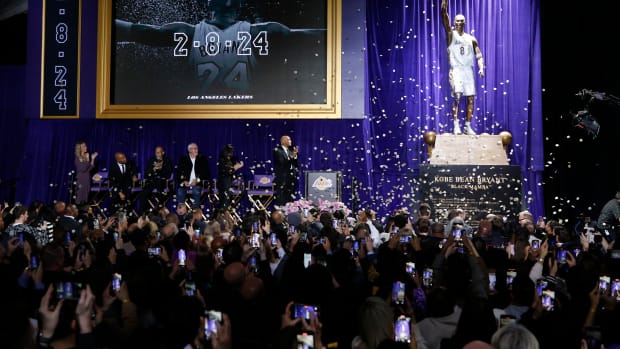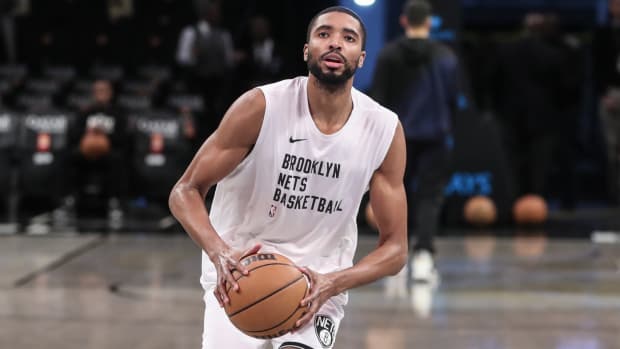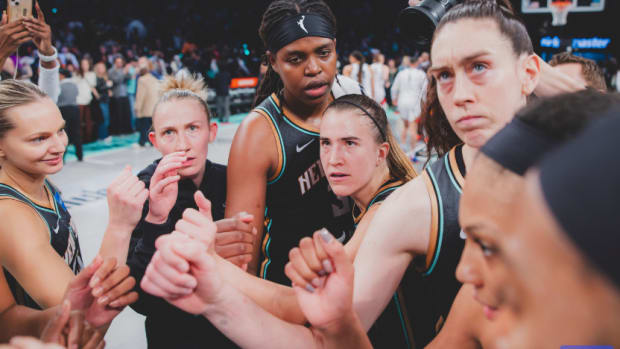Finals being decided in the paint
Three and a half minutes remained in the opening half of Game 1 of the NBA Finals, and Kobe Bryant was in the midst of one of his Basketball Jesus impersonations. Thirty feet from the basket, his face scrunched up in a mask of determination, he dribbled toward Orlando guard Mickael Pietrus, a nice young man from France who was having a very bad evening. On the previous play Pietrus had seemingly stopped Bryant only to watch as the Lakers' guard pivoted, spun, pivoted again and then arced in an implausible fadeaway. Now, with Bryant on the attack again, the fans at Staples Center -- on the celebrity-flecked sideline, in the inebriated depths of the second deck, even in the luxury boxes, where concentrating on the game is generally deemed uncouth -- all fixated on Kobe, reluctant to look away lest they miss some bit of offensive poetry worthy of recital in the years to come.
Once Bryant scored -- and of course he did, on a pull-up that was part of a 30-point eruption over 16 minutes -- most of the fans exhaled, knowing they could look away for a moment, or at least until Los Angeles regained possession. But those who did risked missing an even more important spectacle, for it was on the other end of the court, down near the basket, where this series was being won and lost. That's where a gangly man with a tangle of brown hair and a patchwork beard (that would be Lakers forward Pau Gasol) spent much of the first two games methodically jabbing his forearm into the unyielding midsection of a towering man with cartoon deltoids (Orlando center Dwight Howard). Howard then would push back into Gasol, giving them the appearance of two very large kids jostling for a spot in line at an ice-cream stand.
As much as the first two games in these Finals could be viewed as the Kobe Bryant Show -- and rightfully so, considering his exquisite Game 1 performance and the team-leading 29 points he scored in Game 2, both Lakers victories -- his contributions were to be expected. This is, after all, a man who at age 30 has already scored more postseason points than all but five players in history and who remains the most gifted offensive player alive. (And, amusingly, is again being deemed the league's best overall player, only weeks after the title was officially, nonrefundably bestowed upon LeBron James.) As Howard put it after a 100-75 rout by L.A. in the opener, "We can't control Kobe having 40 points."
This may well be true, which brings us back to what both teams desperately need to control: the paint. The 23-year-old Howard prefers to muscle his way into post position before, in the words of L.A. assistant Brian Shaw, "pile-driving" to the basket; his mere presence down low draws defenders and creates open looks for his three-point-hoisting teammates. Gasol, at 28, is a 7-foot facilitator equally adept at posting up, slipping the ball to a cutting teammate and putting it on the floor. "They're about as different as big men get," says an Eastern Conference scout who is following the Finals, "but they're both a real bitch to prepare for."
Howard is so central to the Magic offense that the Lakers geared their entire defensive scheme toward neutralizing him. From the start of Game 1, whenever Howard caught the ball and turned, he found a yellow jersey either hurtling toward him or already stationed in his path. Howard finished with one field goal on six shots -- can you imagine Bryant finishing a Finals game with one field goal? -- and only 12 points. In Game 2, a 101-96 loss in overtime, he did better, racking up 17 points on 5-of-10 shooting, but he was harassed into seven turnovers. What's more, his first dunk of the series didn't come until midway through the third quarter of Game 2, which probably missed the over-under by about, oh, six quarters. Afterward Howard admitted that he was frustrated, crediting Los Angeles for doing "some crazy things" on defense.
Of course, one man's crazy is another's measured strategy, and the Lakers deserve credit for devising a multifaceted approach. First, they understood that with Howard the work starts early. Because of his speed -- he finished third in a three-quarter-court sprint when strength coach Joe Rogowski timed all the Magic in the preseason -- he is deadly when making "rim runs" in transition, beating opposing (and usually lumbering) big men downcourt to get deep post position. "You can have a half-court game plan to stop him, but it doesn't matter in transition because everyone's scrambling," says Mike Malone, the Cavaliers' lead defensive assistant, who spent the Eastern Conference finals struggling to solve the puzzle of Howard. "And if he gets that deep, how do you guard a guy like that when he's already got two feet in the paint?"
Thus every time Orlando gains possession, Gasol and L.A. centerAndrew Bynum turn and sprint back to their own basket as if trying to outrun an avalanche. At the same time the Lakers' guards will veer into Howard's path to slow him down and buy their big men another step or two. (Knowing the importance of beating Howard downcourt, by the way, helps explain why Cleveland's plodding Zydrunas Ilgauskas was not exactly an ideal matchup.)
Once Howard gets the ball, usually on the left block, Los Angeles mixes up where the double teams come from and when. Sometimes it's on the catch, with a guard darting down from the top of the key; sometimes it's on the dribble, using a defender lurking along the baseline; and sometimes, as in the second quarter of Game 2 when power forward Lamar Odom flitted over, it arrives before Howard even gets the ball. If Howard is still able to make his move to the middle, more trouble awaits. Since L.A. knows Howard prefers to take running righthanded hooks, they can send their long-armed minions -- Odom, Bryant and forward Trevor Ariza -- not directly at Howard but rather to the spot where he will release his shot, aware that Howard's game is not yet refined enough that he can come to a jump-stop or kick the ball out once in motion. "We try to jam the lane a little bit because obviously it's hard to pass on the move when you're a post player," explains Gasol. "He's becoming a better passer, but I don't think he's a great passer yet. So we make him detour so he doesn't get a good rhythm."
Once a shot goes up, the next challenge is keeping Howard off the boards; he's averaging 4.5 offensive rebounds during the postseason and, as Gasol says drily, "I don't think I'm going to be outjumping him." The Lakers' solution is not to grab the board as much as redirect it from Howard's sizable mitts, with their perimeter players flying in and swatting at the ball. "Against a team that plays four-out, one-in like Orlando," explains Shaw, "instead of having [our perimeter] guys stay [outside], we have them run in and at least try to tip the ball."
Finally for the Lakers: If all else fails, fall. This was Gasol's strategy in Game 1 -- and yes, it could also be the title of a Vlade Divac hoops biography -- when he took a charge on Howard the first time the two matched up, waiting for Howard to spin baseline and then crumbling on contact. Not long after, Gasol drew another charge, forcing Howard to become tentative for fear of foul trouble. Bynum took the opposite tack, bodying Howard and then, if the Orlando center got within arm's reach of the hoop (which is to say, monster-dunk range), wrapping him up as if applying an impromptu Heimlich. Interestingly, this is not a coaching strategy but a Bynum strategy. "The staff and the organization tell me, You're better than that, play him in there," confides Bynum, who has not fully recovered from a torn right MCL he suffered on Jan. 31. "But maybe he gets a dunk, maybe his shots start falling. I want to make sure he doesn't get going."
Credit Howard for trying to mix it up in Game 2. He turned and fired a face-up jumper. (Bad idea; it clanked off the back of the rim.) He passed out and reposted. (Better idea, but he still missed a contested jump hook.) And he held the ball, seeking open shooters to feed. (Great idea; he had four assists and helped free up forward Rashard Lewis for 34 points.) Still, if the Magic is to have a chance in this series, he'll have to be more prolific as a scorer, and he knows it, vowing after Game 2 to "do his homework."
As Howard deals with a defense geared to stop him, Gasol has the luxury of exploiting the cracks in a defense geared to stop his teammate. (And no, we speak not of Sasha Vujacic.) Gasol's game is quiet -- it's always a mild surprise to look at the stat sheet and see he had 24 points and 10 rebounds, as he did in Game 2 -- but as refined as that of any big man. He can shoot hooks and runners with either hand, is widely considered the best-passing big man in the league, and as Odom says, "His hand-eye coordination is remarkable for someone that size. He never drops the ball."
If Gasol appears to at times play like an oversized point guard, it's because he was one until he was 13. Upon arriving in the NBA from his native Spain eight years ago, however, Gasol was promptly shuttled into the post, where American coaches believe 7-footers belong. Still, he has retained his playmaking touch. This provides a dilemma for Orlando; if it double-teams Bryant and he gets the ball to Gasol, he can essentially direct a four-on-three. "And nine times out of 10 he's going to make the right play in that situation," says Malone.
The accepted best strategy against Gasol, then, is to play off him on the perimeter and concede the jump shot, as the Rockets did in the Western Conference semifinals. (Houston's stats gurus determined that the most inefficient aspect of the Lakers' offense was a Gasol jumper, and indeed for the season he shot 40.6% from 17 feet out to the three-point line, according to Synergy Sports Technology.) The Magic followed suit, and so, time and again in Games 1 and 2, Gasol had open 17-footers. And time and again he knocked them down, an improvement he credits to his exaggerated follow-through, in which his right arm resembles a swan's neck after each release. "I'm anticipating that I'm going to have five looks to make that shot every game, and it's in my hands to do it," he says. "When I fall back instead of following through, that's when I tend to miss."
Along with upgrading his jump shot, Gasol is also slowly shedding a reputation for being soft. (Although it would be a stretch to call him hard now; less pliable is about right.) Thanks to his improved regimen with weights this season -- which is to say, he now lifts them -- Gasol has been more physical, especially during the playoffs. In the conference finals he traded body blows with Nuggets center Nenê and through two games had done a commendable job of guarding Howard one-on-one in the Finals. Shaw notes how Gasol is now "absorbing that lowered shoulder from Dwight, which is crucial." Bryant has noticed too, saying, "He's able to take more contact on defense. He's able to hold his position a lot more."
In the event that Gasol doesn't hold position, no doubt Bryant will be sure to let him know -- in Spanish, if he prefers, as Bryant often switches to Gasol's native tongue -- for the star guard has been as vocal as ever in these Finals, whether it is encouraging, leading or berating. Much has been made of Bryant's seriousness of purpose this postseason, of how he has "the smell," as coach Phil Jackson puts it. And indeed it has been fascinating to watch him, whether he is doing something sublime (like banking in a hanging and-one over Howard in Game 1) or inexcusable (like going one-on-four at the end of regulation in Game 2 while Ariza stood all alone on the three-point line, waving his arms as if trying to flag down a rescue plane).
So watch Kobe at all times if you must, and granted it's hard not to, but also keep an eye out for the big lugs in the middle. After all, they'll only decide the NBA championship.
To subscribe to Sports Illustrated magazine, click here.






























